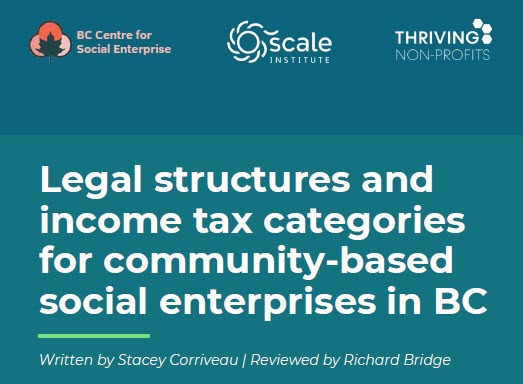Note: an alternative hybrid option was introduced in British Columbia in 2020: the Benefit Company.
The number of Benefit Companies at play had already outpaced Community Contribution Companies (C3’s) by a factor of 14 by March 2025. At that time, just over 60 C3’s were active, with 55 additional C3’s dissolved: either voluntarily or due to failure to file Annual Reports.
The number of active C3’s has remained nearly unchanged since 2020: the first year that Benefit Companies became available.
If considering the C3 legal structure for your social enterprise, please also review the features of the Benefit Company option.
Both the C3 and the Benefit Company are taxable corporations. Neither can issue donation receipts.
What is a community contribution company?
In 2012, amendments were made to the BC Business Corporations Act, which, among other things, legislated the first hybrid social enterprise structure in Canada: the Community Contribution Company… or C3 for short.
The option has been available in BC since mid-2013.
In 2016, Bridget Horel, as part of her MBA research at Cape Breton University, undertook an extensive survey of some of the pioneering C3’s. Her summary of research findings can be found here. The document also includes a listing of the C3’s that had incorporated by the end of 2015.
In 2021, Chiyi Tam, in her graduate studies at University of Toronto’s Graduate Planning Program, produced an outstanding paper: Social Enterprise as Building Back Better: A Review of Community Contribution Companies. It’s a must-read for those considering the formation of a C3.
Information on the steps required to incorporate a C3 is available on this BC Ministry of Finance webpage.
A rather prescient article written by Angela Lee less than two years after the C3’s introduction can be found here: Vague, Voluntary, and Void: A Critique of the British Columbia Community Contribution Company Hybrid Model.
For an article on Nova Scotia’s social enterprise hybrid structure — the Community Interest Company — please click here. This option was introduced in 2016.
C3 Features
The C3 very much mimics the UK’s Community Interest Company.
As the C3 is a taxable corporation (taxed at regular corporate rates), there is no doubt that this structure can be used to do business, and generate profits — elements that are not so expressly stated for charities and non-profit organizations.
The C3 features a 40% cap on dividends paid out to investors, to enable more capital to remain within the social enterprise, and to flow unfettered to qualified entities such as charities.
A C3 cannot issue official donation receipts, as a charitable organization can.
It must have at least three directors, but can have one or more shareholders.
In cases of C3 dissolution, the majority of assets remaining after debts are settled must flow to a qualified entity.
An additional layer of transparent community reporting is required at year-end, showing how the C3 has manifested its social, cultural, or environmental goals (which must be embedded in its articles of incorporation).
C3 Uses
The C3 could serve as a suitable container for charities operating unrelated businesses.
The C3 option may also be attractive to traditional corporations wishing to entrench goals beyond that of maximizing shareholder profits.
The question of whether a non-profit organization (i.e. without charitable status) can own a C3 is more nebulous. Non-profit ownership of a C3 may signal profit intent, which could jeopardize the income tax exemption of the non-profit parent. CRA will provide opinions on a case-by-case basis.

Setting up a C3
Please note that there are no grants for establishing or operating C3’s, as these are structured as taxable corporations.
Contact us by email, to be connected with specific lawyers who have experience in incorporating this fairly new structure. Their own fees would apply.
As with regular incorporations, the option also exists for do-it-yourself C3 incorporation. Click here for more information.
If you have a BC corporation already, and wish to migrate to the C3 structure, a Notice of Alteration must be completed online after submitting a Name Request indicating the ‘CCC – BC to CCC Conversion’ option.

The Structure Shop Project
With the generous support of the Vancouver Foundation, we built and delivered Structure Shop learning sessions, covering C3’s and other legal structures for social enterprise. These free workshops were convened in Vancouver and Victoria just before the C3 option became available. Click here to view the Structure Shop slideshow.
- To view the Bill 23 legislative amendments to the Business Corporations Act, which enable Community Contribution Companies, click here.
- To access the accompanying regulations for Community Contribution Companies, click here.
- To review an informative paper on choosing the best legal structure for your own situation, click here.
LATEST NEWS & PUBLICATIONS
Prepare for impact: legal structures and income tax categories eBook
Do you operate a social enterprise in BC? Or [...]
Free GrantScan resource assists Canadian organizations to access unrestricted grants and funding for operations, administration, overhead, and capacity building
We’re pleased to share news about a resource for accessing [...]
The Canadian Social Enterprise Directory is now live — add your free listing
A new, searchable online directory of Canadian social enterprises is [...]



